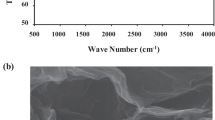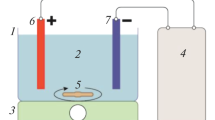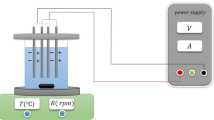Abstract
The objective of this study was to examine the performance of the proxy electrocoagulation method in removing Cefixime (CFX) from water. This study was performed on a laboratory scale on synthetic samples of the antibiotic CFX in a batch reactor. In this study, the effect of five parameters was investigated, such as initial CFX concentration, Hydrogen peroxide concentration, pH, current intensity and reaction time. The results show that under optimal conditions, Proxy Electrocoagulation Process can remove CFX up to 92.25% with a desirability of 1.0. Central composite design (CCD) proposed a quadratic model for this process. Hydrogen peroxide concentration, solution pH, current density and reaction time, was investigated using a CCD. The adequacy of the model was confirmed using statistical tests such as; F-values of 17.66, p-values of 0.0001 and lack of fit of 0.552 for the model, respectively, R2 = 0.819, R2adj = 0.77, R2pred = 0.66, AP = 19.23. Peroxidation electrocoagulation can be an effective method in removing the antibiotic CFX from water. Of course, more research should be done economically compared to other methods.
Graphic abstract




Similar content being viewed by others
References
Ebadati N (2014) Water Quality evaluation of Dez River in the Dezful hydrometric station. Iran J Ecohydrol 1(2):69–81
Baaloudj O, Assadi I, Nasrallah N et al (2021) Simultaneous removal of antibiotics and inactivation of antibiotic-resistant bacteria by photocatalysis: a review. J Water Process Eng 42:102089. https://doi.org/10.1016/j.jwpe.2021.102089
Gökkuş Ö, Yıldız YŞ (2016) Application of electro-Fenton process for medical waste sterilization plant wastewater. Desalin Water Treat 57:24934–24945. https://doi.org/10.1080/19443994.2016.1143882
Fanourakis SK, Peña-Bahamonde J, Bandara PC, Rodrigues DF (2020) Nano-based adsorbent and photocatalyst use for pharmaceutical contaminant removal during indirect potable water reuse. NPJ Clean Water. https://doi.org/10.1038/s41545-019-0048-8
Naeem Khan M, Qayum A, Ur Rehman U et al (2015) Spectrophotometric method for quantitative determination of cefixime in bulk and pharmaceutical preparation using ferroin complex. J Appl Spectrosc 82:705–711. https://doi.org/10.1007/s10812-015-0167-z
Baaloudj O, Nasrallah N, Kebir M et al (2020) Artificial neural network modeling of cefixime photodegradation by synthesized CoBi2O4 nanoparticles. Environ Sci Pollut Res 28:15436–15452. https://doi.org/10.1007/s11356-020-11716-w
Hasanzadeh V, Rahmanian O, Heidari M (2020) Cefixime adsorption onto activated carbon prepared by dry thermochemical activation of date fruit residues. Microchem J 152:104261. https://doi.org/10.1016/j.microc.2019.104261
Benrighi Y, Nasrallah N, Chaabane T et al (2021) Photocatalytic performances of ZnCr2O4 nanoparticles for cephalosporins removal: structural, optical and electrochemical properties. Opt Mater (Amst) 115:111035. https://doi.org/10.1016/j.optmat.2021.111035
Mostafaloo R, Mahmoudian MH, Asadi-Ghalhari M (2019) BiFeO3/Magnetic nanocomposites for the photocatalytic degradation of cefixime from aqueous solutions under visible light. J Photochem Photobiol A Chem 382:111926. https://doi.org/10.1016/j.jphotochem.2019.111926
Sorenson SB, Morssink C, Campos PA (2011) Safe access to safe water in low income countries: water fetching in current times. Soc Sci Med 72:1522–1526. https://doi.org/10.1016/j.socscimed.2011.03.010
Ahmed Y, Huang YL, Martin A, Otten B (2015) Assessment of the relation between water quality and water quantity for international metropolitan cities. World Environ Water Resour Congr, pp 669–684. https://doi.org/10.1061/9780784479162.062
Wilcox J, Nasiri F, Bell S, Rahaman MS (2016) Urban water reuse: a triple bottom line assessment framework and review. Sustain Cities Soc 27:448–456. https://doi.org/10.1016/j.scs.2016.06.021
Kenfoud H, Baaloudj O, Nasrallah N et al (2021) Structural and electrochemical characterizations of Bi12CoO20 sillenite crystals: degradation and reduction of organic and inorganic pollutants. J Mater Sci Mater Electron. https://doi.org/10.1007/s10854-021-06194-w
Esfandyari Y, Saeb K, Tavana A et al (2019) Effective removal of cefazolin from hospital wastewater by the electrocoagulation process. Water Sci Technol 80:2422–2429. https://doi.org/10.2166/wst.2020.003
Baaloudj O, Nasrallah N, Assadi AA (2021) Facile synthesis, structural and optical characterizations of Bi12ZnO20 sillenite crystals: application for Cefuroxime removal from wastewater. Mater Lett. https://doi.org/10.1016/j.matlet.2021.130658
Baaloudj O, Nasrallah N, Kebir M et al (2020) A comparative study of ceramic nanoparticles synthesized for antibiotic removal: catalysis characterization and photocatalytic performance modeling. Environ Sci Pollut Res 28:13900–13912. https://doi.org/10.1007/s11356-020-11616-z
Cruz KD, Madrid CJM (2019) Electrocoagulation-H2O2-dimethicone combined system for COD reduction and phosphate removal of sewage wastewater. E3S Web Conf 117:0–5. https://doi.org/10.1051/e3sconf/201911700004
Gökkuş Ö, Yildiz YŞ (2015) Application of electrocoagulation for treatment of medical waste sterilization plant wastewater and optimization of the experimental conditions. Clean Technol Environ Policy 17:1717–1725. https://doi.org/10.1007/s10098-014-0897-2
Vale-Júnior E, Silva DR, Fajardo AS, Martínez-Huitle CA (2018) Treatment of an azo dye effluent by peroxi-coagulation and its comparison to traditional electrochemical advanced processes. Chemosphere 204:548–555. https://doi.org/10.1016/j.chemosphere.2018.04.007
Shaykhi ZM, Zinatizadeh AAL (2014) Statistical modeling of photocatalytic degradation of synthetic amoxicillin wastewater (SAW) in an immobilized TiO2 photocatalytic reactor using response surface methodology (RSM). J Taiwan Inst Chem Eng 45:1717–1726. https://doi.org/10.1016/j.jtice.2013.12.024
Mostafaloo R (2020) Analytical & modeling and optimization of the electrochemical process. Anal Bioanal Electrochem 12:36–47
Behera SK, Meena H, Chakraborty S, Meikap BC (2018) Application of response surface methodology (RSM) for optimization of leaching parameters for ash reduction from low-grade coal. Int J Min Sci Technol 28:621–629. https://doi.org/10.1016/j.ijmst.2018.04.014
Voss D, Dean A, Draguljic D (2017) Design and analysis of experiments. Springer texts in statistics. Springer, New York
Lee TZE, Krongchai C, Mohd Irwn Lu NAL et al (2015) Application of central composite design for optimization of the removal of humic substances using coconut copra. Int J Ind Chem 6:185–191. https://doi.org/10.1007/s40090-015-0041-0
Ouaissa YA, Chabani M, Amrane A, Bensmaili A (2014) Removal of tetracycline by electrocoagulation: kinetic and isotherm modeling through adsorption. J Environ Chem Eng 2:177–184. https://doi.org/10.1016/j.jece.2013.12.009
Arsand DR, Kümmerer K, Martins AF (2013) Removal of dexamethasone from aqueous solution and hospital wastewater by electrocoagulation. Sci Total Environ 443:351–357. https://doi.org/10.1016/j.scitotenv.2012.10.100
Jiménez C, Sáez C, Martínez F et al (2012) Electrochemical dosing of iron and aluminum in continuous processes: a key step to explain electro-coagulation processes. Sep Purif Technol 98:102–108. https://doi.org/10.1016/j.seppur.2012.07.005
Acknowledgements
The authors would like to thank Qom University of Medical Sciences for supporting the current study.
Funding
This research received no external funding.
Author information
Authors and Affiliations
Contributions
MA-G: writing-original draft preparation, RM: supervision, NG: writing—review and editing, AK: visualization, SU: conceptualization, OB: supervision.
Corresponding author
Additional information
Publisher's Note
Springer Nature remains neutral with regard to jurisdictional claims in published maps and institutional affiliations.
Rights and permissions
About this article
Cite this article
Asadi-Ghalhari, M., Mostafaloo, R., Ghafouri, N. et al. Removal of Cefixime from aqueous solutions via proxy electrocoagulation: modeling and optimization by response surface methodology. Reac Kinet Mech Cat 134, 459–471 (2021). https://doi.org/10.1007/s11144-021-02055-z
Received:
Accepted:
Published:
Issue Date:
DOI: https://doi.org/10.1007/s11144-021-02055-z




